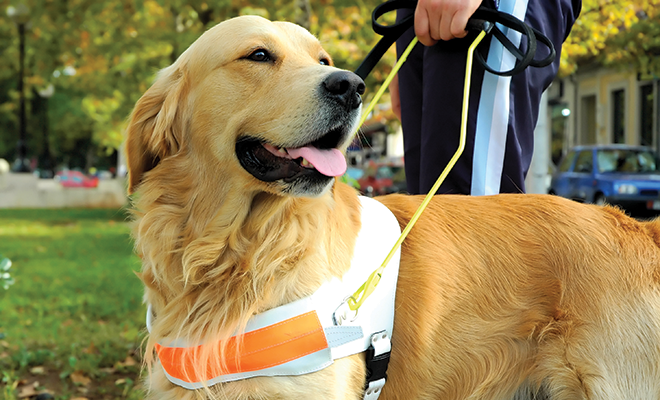
National Service Dog Month
I have a bone to pick with service dogs. When I went off to college, my parents replaced me with one. That wasn’t their intent, but it was uncanny timing. They hadn’t let me have a dog all my life,
and suddenly when I left, they allowed my little sister, Phoebe, to adopt a puppy.
They agreed to the deal only because it wasn’t permanent; she was a volunteer puppy raiser for Canine Companions for Independence, a non-profit that trains service dogs for people with disabilities. The organization sent us a puppy, and my sister’s job was to raise him for a year, socialize him and take him to behavior classes. Then she would return him to the organization, where he would undergo further specialized training to become a helping dog.
The dog my sister raised was specially bred for the program, so he was sweet and lovable. When I visited from college, I had some mild resentment for this new family member (and it didn’t help that more than once my mom called me by the dog’s name) but he melted my heart with his affection. At the end of his training, the dog was tested to see if he had the potential to be a professional helping dog. As part of the test, the dog was supposed to sit and stay while a volunteer paraded a live rabbit in front of him. Unfortunately, the dog had no experience with small animals, and as an enthusiastic golden retriever, he wasn’t about to pass up a chance to play. He lunged forward, the rabbit nearly lost its life, and that was the end of this dog’s service career. He was adopted by another family as a pet.
I say all that to illustrate a point: service dogs are amazing. They are not just any old dogs. Many of them are bred specifically for their functions, they are given highly specialized training, and even then, not every dog makes the cut; dogs who end up in the line of service are the cream of the crop. Still, 50 percent to 70 percent of service dogs fail out of their training programs.
There are many devoted dogs who help people by giving them caring companionship, including therapy dogs and emotional support dogs. In the law, service dogs are defined differently from those categories of dogs because they have been specifically trained to perform a task.
According to the Americans with Disabilities Act National Network, the tasks performed by service dogs cover an incredible range of daily activities. For example, seeing eye dogs or guide dogs are trained to help their human handlers navigate environments and avoid danger. Hearing dogs can let hearing-impaired handlers know when they hear certain sounds, such as a knock on the door. Psychiatric service dogs can remind handlers to take medications, turn on lights or stop them from self-harm. Sensory signal dogs alert people with autism when they are performing repetitive movements unawares. Seizure response dogs can alert people before they have seizures, guard them during the episode, or even go get help. Service dogs for physically handicapped people can also push elevator buttons, pull wheelchairs and pick up dropped items.
Service animals have certain legal rights. According to Titles II and III of the Americans with Disabilities Act, these animals are allowed to have access to any areas that are open to the public, even businesses that have a “no pets” policy, because service animals are not pets. If business owners are concerned about letting animals into their facilities, they are allowed to ask only the following two questions: “Is this animal required because of a disability?” and “What work or task has the animal been trained to perform?” If the dog in question has been individually trained to perform a service task, then it is a service dog, and it must be allowed to enter with its handler. In contrast, emotional support animals for comfort are not specially trained or legally recognized the same way, and businesses are not required to give them public access.
There are currently about half a million service dogs in the U.S. Of these, only about 10,000 are working as guide dogs for the blind, and about 5,000 are trained as hearing dogs for the deaf. It takes an average of 18 months to train a service dog, so the training can cost $10,000 to $20,000. These dogs are in high demand, so the average wait time for a disabled person to attain a service dog is about three years. Many Americans gratefully share a long-term bond with their service animals, and we should all applaud the dedication of these dogs and the people who train and handle them, even if they sometimes make mistakes and call us by their dogs’ names! ■
Sources: canine.org, adata.org and doggiedesigner.com.







